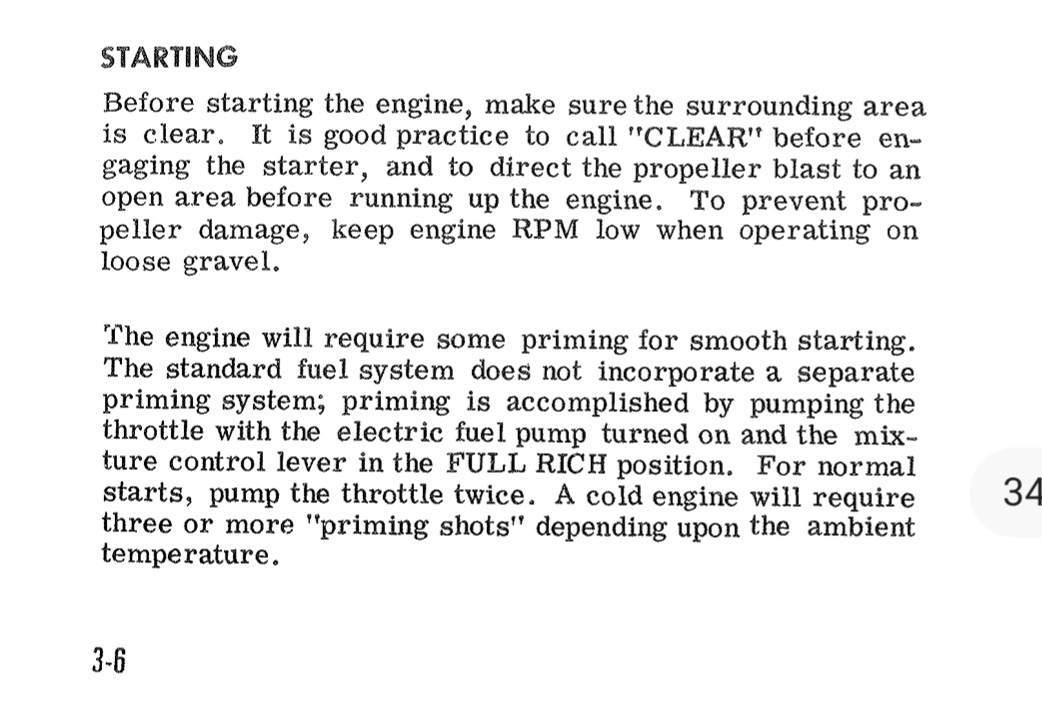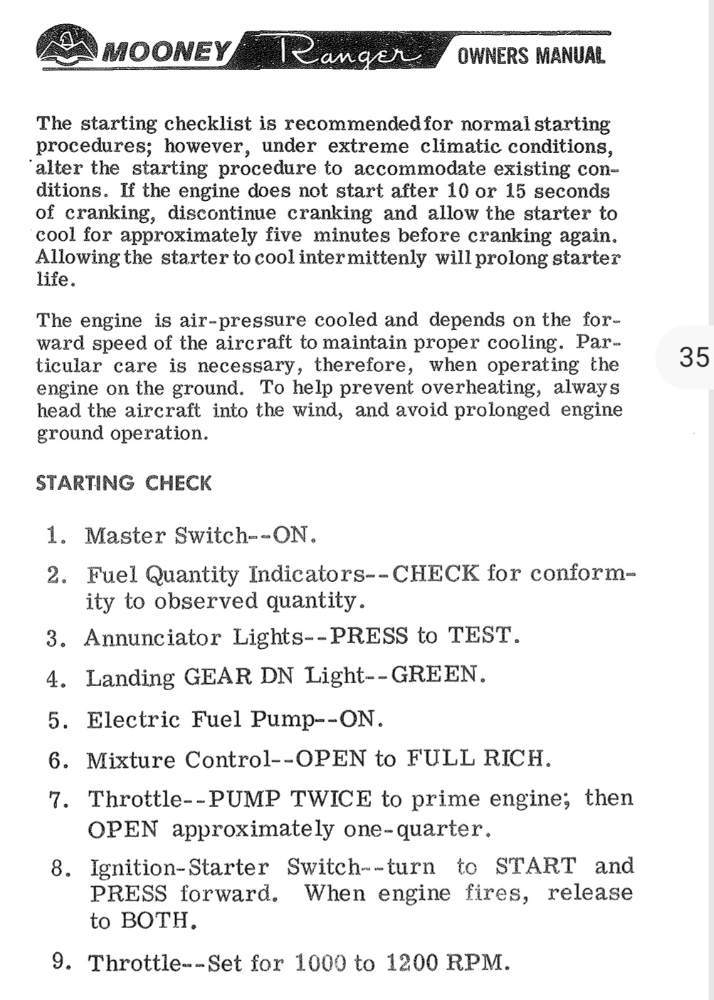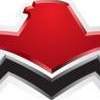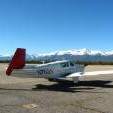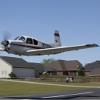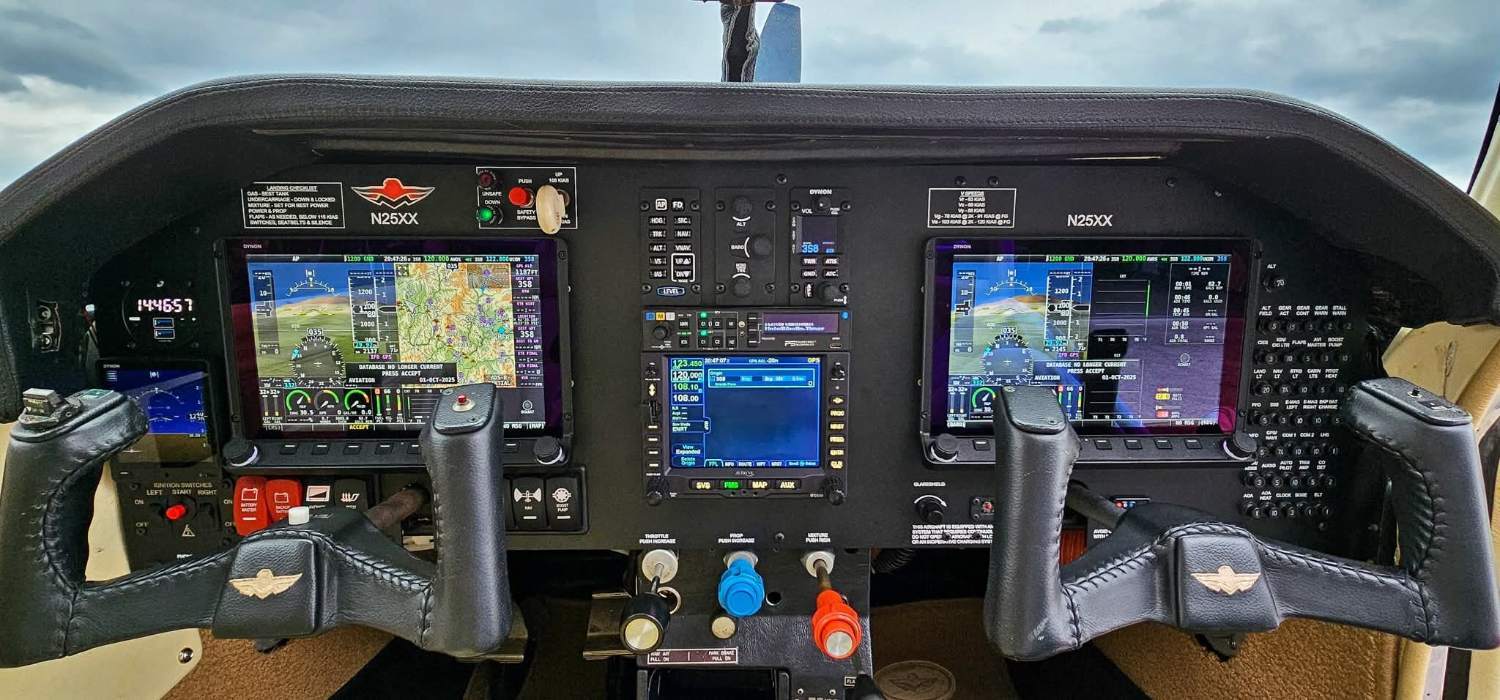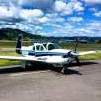All Activity
- Past hour
-
I always start IO-360s the same no matter what the temperature. It never fails. Mixture rich, throttle at ~1000 RPM setting. Crank the starter, if it isn’t making fuel pressure, I’ll turn on the boost pump until I have fuel pressure, then turn it off. The only time I prime is if I think it is flooded, I will prime to make sure it is flooded, then do a flooded start. Hot start is mixture ICO, throttle 1000 RPM, crank till it starts, then advance the mixture. Flooded start is the same as hot start, but with more throttle. When it finally catches, reduce the throttle and when it starts to die, advance the mixture.
- Yesterday
-
One thing for sure… if you have learned to use a certain amount of prime in warm weather… and the temps have cooled a bit… less prime won’t make any sense (to a chemical engineer). 100LL is known for its inability to evaporate as temps cool… the IO550 uses 40°F as the cut-off from normal start to cold start… where additional seconds of prime are used… and running the fuel pump on Lo to keep it running for a few more seconds… read up on various starts to understand them better… as a flooded start may be in your future… Best regards, -a-
-

CO2 detectors the "Good The Bad and The Ugly
Hank replied to Jpravi8tor's topic in Vintage Mooneys (pre-J models)
All I've ever seen in my Mooney is 0; even my old Ford Ranger showed 0 running the heater in winter. I even checked my gas stove, oven and gas logs in the fireplace--all read 0 in steady use, with an occasional startup reading as high as 6. Any reading of 440, much less 800, requires investigation. Check sealing around all hoses and wires through the firewall, sealing around where rudder pedals and aileron rods leave the cabin, along with the seam tape under the cabin. -

Rght out of the gate? Seriously???
Hank replied to Freddb34's topic in Vintage Mooneys (pre-J models)
Many people swear by a tool made.from PVC pipe and notched to fit over the fuel selector, with the handle end either an L or T to suit pilot preference and storage location. Make the length and handle style to suit yourself. Or learn to lean down and turn it by hand. By the time you finish your insurance dual, you should be pretty proficient; i switch mine on the ground after engine start to ensure that it's trouble-free, then check it's on the fullest tank for takeoff, and again every hour in cruise. -
No worries Hank (on derailing). I am going to try and prove I am not crazy (doing same thing over and over and expecting different result) and try less boost pump. (opposite of more cow bell if you are a Blue Oyster Cult/SNL fan).
-
I though of putting the O2D2 controller somewhere in line of sight, but could not come up with a solution that would be somewhat elegant. my O2 ports are in the ceiling (1990 Bravo) above/behind the front seats and running hose to front panel would not look very good. Thus, I chose to attach the controller with 3M Dual Lock Strips bewteen the rear seats where I can easily reach it and manipulate the control knob. There is arguably no need for visual confirmation of function with this unit as you can clearly hear the pulses being delivered (I now that some pilots do not like this, but I got used to it quite quickly). I can still glance at the box periodically to see the green lights and confirm that battery is OK. All the hoses are out of the way behind the seats and the setup works really well. No overheating issues as the box never gets direct sun.
-
@Vance Harral, I'm not aware of ANY carbureted Mooneys with separate primer functions like found on the 172s I trained in. When cranking in very cold weather, I sometimes also pump the throttle a few times as the engine turns over, especially if it fires unsuccessfully a couple of times. Unless the engine is flooded, there is little risk of an engine fire. At the risk of derailing discussion here, this is from my Owners Manual:
-
Fresh out of annual? Fresh grease gets pushed into the hub causing some to escape out the seals… deep cycling the prop? another reason some grease may get past a seal that has been sitting awhile… when grease comes out three inches of prop blade… it will leave small bits of grease on the windscreen… a clean windscreen is required to see it… let’s invite… @Cody Stallings for some insight on prop grease leaking… Best regards, -a-
-
Seems pretty straight forward - not even close to what you are thinking. https://www.navcanada.ca/en/corporate/service-charges.aspx
-
Mine was overhauled around the time of the Aeroshell issue. But it leaked before and after, so who knows? I think Nyco is the new recommendation, but can’t be mixed with the Aeroshell. However, you can mix Aeroshell 5 with 6, FWIW.
-
@Hank probably knows this, but just for others reading the thread... some carbureted aircraft don't have a primer systems that inject fuel directly into the cylinders. Including some Mooneys, and I'm guessing Hank's is one of them. Pumping the throttle to force the accelerator pump to spray atomized fuel up into the carburetor throat is the only way to prime the engine in these airplanes. But please be careful about dispensing "pump the throttle to prime" advice, even in carbureted aircraft. Most carbureted airplanes have updraft carbs (fuel/air path into the engine intake is opposite gravity), and some of them don't atomize the fuel all that well, especially when it's cold. In these aircraft, some of the fuel you shoot into the carburetor throat by pumping the throttle runs back down over the carburetor, into the engine cowl, onto the ground, etc. This is a fire hazard, and not just a theoretical one - a 182 at our flight school suffered significant damage in a carburetor fire caused by someone who wasn't very skilled getting the engine started, and managed to light off an engine compartment fire after excessive throttle pumping. It's definitely safer to use a primer vs. pumping the throttle, though the risk reduction is hard to quantify. If you must pump the throttle to get the engine started, one way to mitigate risk is to only pump the throttle while actually cranking the starter. With this method, the vacuum generated in the intake by the moving cylinders will draw more of the fuel droplets up into the engine, less of them will rain down on the ground. I'm aware this isn't the POH procedure, but it has been effective for me in a number of carbureted airplanes, and I think it's safer. The "hot start problem" in fuel injected engines is almost entirely caused by the the fuel injector lines being routed right over the cylinder heads, such that the fuel in them is baked and vaporized by the hot cylinders as soon as cooling air stops flowing over them, i.e. immediately after shutdown. Lycoming/Continental carbureted engines don't have this problem because the entire fuel/air intake system is below the hot cylinder heads, so there's really no comparison between carbuerted/fuel-injected with regard to hot starts. Indeed, carbureted engines are almost always blissfully easy to start when warm. For what it's worth, your engine would likely start with zero throttle pumps when warm, albeit after a few more blades than with pumping. Reduces the admittedly small risk of a carburetor fire, at the expense of more wear on your starter.
-
Given those two data points, it sounds like a real issue. Are you sure that the oil cooler lines are connected properly? What does the overhauler say?
-
takair started following Prop leaking… sometimes?
-
I have come to the opinion that if you service the prop every annual, it eventually gets full (12 years or less if over serviced) and further grease needs a way out. Seems to coincide with recommended OH time. So, full hub….some migrates out the seal. The risk of not servicing is corrosion in the hub and/or dried grease. So, it’s possible you simply have a slightly over serviced hub. The grease breaks down and the oil seeps out. As Yetti said, Arroshell grease got worse over time and is no longer the preferred grease after overhaul.
-
The McCauley manual says to cycle the prop all the way to the low speed/ high pitch stop a few times. I did this and it stopped my minor leaks.
-
Well dang. I’ve heard similar from a friend on the field. Once I realized how many years it had been since overhaul it got me a little rattled, but I guess it’s somewhat common.
-
It’s on the prop. Definitely not on the windscreen.
-
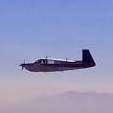
What 2.25" instrument would you add to this panel design?
EricJ replied to birdofjoy's topic in Avionics/Panel Discussion
Nice! I have an IFD540 and a PSE PMA450 audio panel as well. That's a very nice pairing. The whole thing looks very nicely done. -
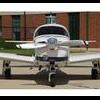
CO2 detectors the "Good The Bad and The Ugly
M20F replied to Jpravi8tor's topic in Vintage Mooneys (pre-J models)
Guardian CO2 interfaced into my MVP-50. Open the door on taxi with a tail wind and it works every time. -
Sounds like a glitch. You definitely need to reach out to them and see what's happening. If it is an automatic charge to your CC, call the bank and tell them it is an error.
-

Rght out of the gate? Seriously???
EricJ replied to Freddb34's topic in Vintage Mooneys (pre-J models)
In any single-engine airplane with a fuel selector with a single tank selected, learn to make it a reflex, without even thinking, that if the engine quits or has a very significant stumble, just switch tanks and turn the boost pump on. It doesn't matter how much fuel is in the selected tank, just do it. Fuel level is only one of many conditions that have to be sufficient in a tank to make the engine work, and if it quit, even if there's fuel, it could have become clogged, had a big slug of water dislodge from a rib, had a big chunk of contamination break loose and become an issue, or hit some other contamination in that tank that just made it to that pick up, plus a number of other potential issues. Switching tanks removes any potential condition associated with that particular tank from being an issue. Don't even think about it, just switch tanks and turn the boost pump on. Make it a reflex. It's not hard to learn to do, but you need to make an effort to do it. If your fuel selector isn't super easy for you to manipulate, practice doing so quickly so that you get muscle memory for that task. -
Ron This was August 2025, for a single flight in and out the charge should have been less. Multiple flights, they may have chosen the best option for you already. And how the heck would you even know if you are going to be charged for 2026? aerodon
-
I have both US and Canadian registered airplanes. From the N#, NavCanada tracked me down and sent a one time C$26 charge for one flight into Victoria. Electing to pay the annual $88 for planes under 2000kg would cover me for the balance of the year. They are pretty good at reversing charges (for example for a plane that was inactive for the whole year). Write an email, they are pretty responsive. This is not unlike airspace in the rest of the world, you don't realize how privileged we all are to fly so freely in the US. Aerodon
-

What 2.25" instrument would you add to this panel design?
pirate replied to birdofjoy's topic in Avionics/Panel Discussion
Very nice! -
What 2.25" instrument would you add to this panel design?
birdofjoy replied to birdofjoy's topic in Avionics/Panel Discussion
I finally completed this upgrade and got the plane back last week. Just wanted to circle back to this thread with the final result. Besides what is shown there, I also got a remote CO detector that I can manage through the PFD. Really happy with the outcome. Now to fly it a bunch to refamiliarize myself with the new panel and then dive deep into IFR training! -
Ragsf15e started following Qs. about NAV Canada charges?
-
I fly to Canada for work occasionally. We definitely don’t get billed on an annual basis, only for the flight time in their airspace. I would call them, write them, and/or not pay.



